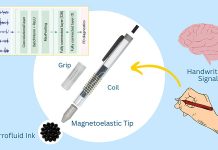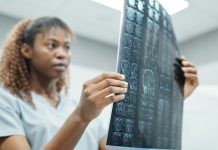
Researchers from around the world have developed a remarkable handheld device that can detect biomarkers associated with Alzheimer’s and Parkinson’s Diseases.
This biosensor offers a non-invasive approach and can wirelessly transmit test results to a laptop or smartphone.
A New Hope for Early Detection
Detecting neurodegenerative diseases like Alzheimer’s and Parkinson’s at an early stage is crucial for effective treatment.
Currently, diagnostic methods involve invasive procedures and complex imaging tests, making early detection challenging. This innovative device could revolutionize the field by enabling simple, non-invasive testing.
The biosensor relies on electrical detection rather than chemical processes, making it easier to use and highly accurate.
It is designed to detect specific biomarkers associated with Alzheimer’s (amyloid beta and tau peptides) and Parkinson’s (alpha synuclein proteins) from saliva and urine samples. Moreover, the device can potentially be adapted to detect biomarkers for other conditions.
In tests using samples from patients, the biosensor demonstrated accuracy on par with existing state-of-the-art methods. It can detect biomarkers at extremely low concentrations, requiring only small sample volumes.
Additionally, the device performed well even when samples contained other proteins, providing reliable results by analyzing multiple biomarkers simultaneously.
The Device’s Operation
The biosensor consists of a chip with a highly sensitive transistor, made of a single-atom-thick graphene layer.
Three electrodes are connected to the chip: source and drain electrodes (linked to the battery’s positive and negative poles) to facilitate electric current flow and a gate electrode to control the current.
Attached to the gate electrode is a single DNA strand that acts as a probe binding specifically to the targeted biomarkers.
Bringing Innovation to Life
This groundbreaking device is a result of extensive expertise and collaboration among researchers worldwide. It is designed for ease of use and has the potential to transform early disease detection.
Future Steps: Researchers are planning further tests using blood plasma and cerebro-spinal fluid, followed by saliva and urine samples. These tests will be conducted in hospital settings and nursing homes.
If successful, the biosensor could receive FDA approval in the next five to six months, with the aim of being available on the market within a year.
This device offers a promising path towards early diagnosis and improved quality of life for individuals at risk of neurodegenerative diseases, and it may pave the way for similar innovations in the future.
If you care about Alzheimer’s disease, please read studies about These places in U.S. have the most cases of Alzheimer’s disease and findings of Scientists confirm the link between COVID-19 and Alzheimer’s disease.
For more information about Alzheimer’s disease, please see recent studies about Scientists link dietary antioxidants to Alzheimer’s prevention and results showing that This diet might shield you from Alzheimer’s disease.
The research findings can be found in PNAS.
Follow us on Twitter for more articles about this topic.
Copyright © 2023 Knowridge Science Report. All rights reserved.



